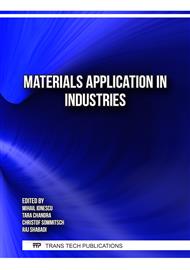p.3
p.11
p.17
p.23
p.31
p.37
p.43
p.51
Damage Accumulation and Recovery Involving Vacancy-Type Defects Enhanced by Hydrogen in Tempered Martensitic Steel Showing Quasi-Cleavage Fracture
Abstract:
Hydrogen embrittlement (HE) is increasingly becoming a critical issue for using high-strength steels in the automotive and infrastructure industries. To overcome the risk posed by HE of structural components under a hydrogen uptake environment in long-term service, it is necessary to clarify the mechanism of HE. In the present study, the presence of hydrogen-enhanced strain-induced vacancies (HESIVs)—one type of defect associated with proposed HE mechanisms—was validated by low-strain-rate tensile tests with in-situ electrochemical hydrogen charging for tempered martensitic steel showing quasi-cleavage fracture with a tensile strength. The effect HESIVs on the mechanical properties of tempered martensitic steel was also studied. The combined use of low-temperature thermal desorption spectroscopy and tensile tests led to the following observations: (i) hydrogen enhanced the accumulation of vacancy-type defects under plastic strain, (ii) accumulated vacancy-type defects adversely affected the ductility of the tempered martensitic steel after hydrogen release, and (iii) aging at 150 °C after applying a given plastic strain with hydrogen charging decreased the amount of newly formed vacancy-type defects and resulted in recovery of ductility.
Info:
Periodical:
Pages:
11-16
Citation:
Online since:
December 2023
Authors:
Price:
Сopyright:
© 2023 Trans Tech Publications Ltd. All Rights Reserved
Share:
Citation:



